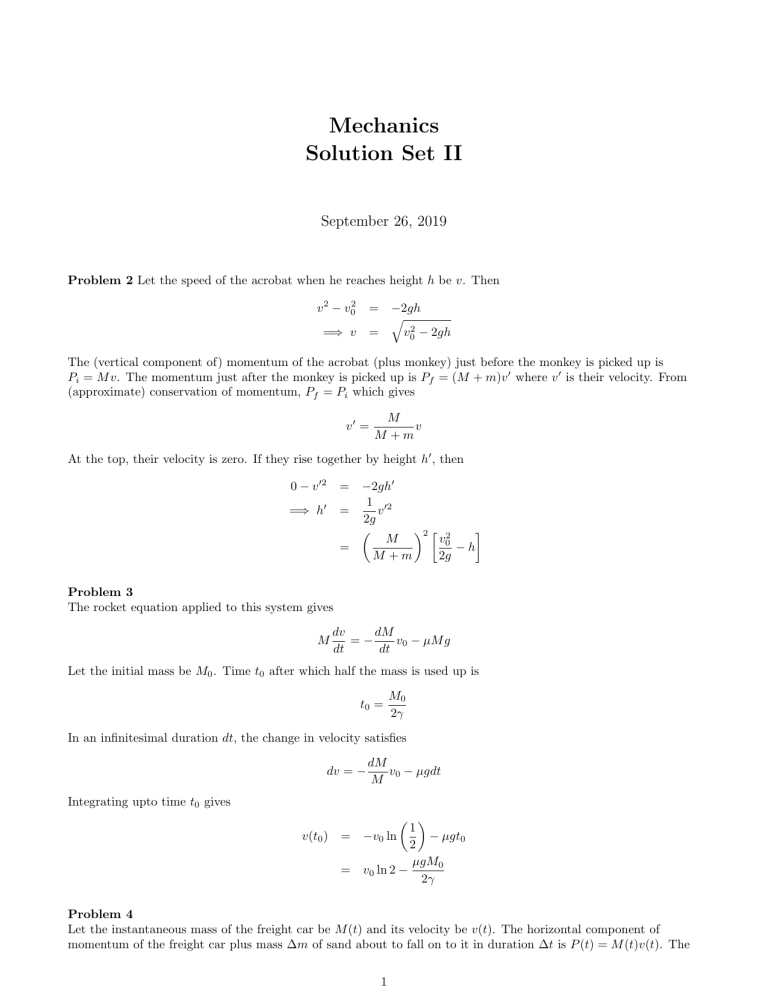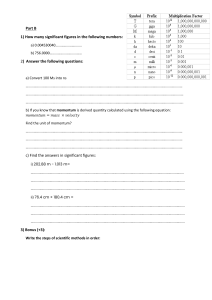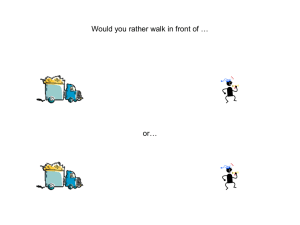
Mechanics Solution Set II September 26, 2019 Problem 2 Let the speed of the acrobat when he reaches height h be v. Then v 2 − v02 = −2gh q = v02 − 2gh =⇒ v The (vertical component of) momentum of the acrobat (plus monkey) just before the monkey is picked up is Pi = M v. The momentum just after the monkey is picked up is Pf = (M + m)v 0 where v 0 is their velocity. From (approximate) conservation of momentum, Pf = Pi which gives v0 = M v M +m At the top, their velocity is zero. If they rise together by height h0 , then 0 − v 02 = −2gh0 1 02 = v 2g 2 2 v0 M −h = M +m 2g =⇒ h0 Problem 3 The rocket equation applied to this system gives M dv dM =− v0 − µM g dt dt Let the initial mass be M0 . Time t0 after which half the mass is used up is t0 = M0 2γ In an infinitesimal duration dt, the change in velocity satisfies dv = − dM v0 − µgdt M Integrating upto time t0 gives 1 v(t0 ) = −v0 ln − µgt0 2 µgM0 = v0 ln 2 − 2γ Problem 4 Let the instantaneous mass of the freight car be M (t) and its velocity be v(t). The horizontal component of momentum of the freight car plus mass ∆m of sand about to fall on to it in duration ∆t is P (t) = M (t)v(t). The 1 momentum of the system at instant t + ∆t is P (t + ∆t) = (M (t) + ∆m)v(t + ∆t). The change in momentum of the system is ∆P = P (t + ∆t) − P (t) = M ∆v + ∆M v Then, the rate of change of momentum is dP dt dv dM + v dt dt = M = d (M v) dt Equating this to the external horizontal force gives d (M v) = f dt Integrating this gives (M + m)v − 0 =⇒ v = Ft Ft = M +m The time it takes for mass m of sand to fall into the freight car is t = m/b. Substituting this gives v= Fm b(M + m) Problem 5 We can use the rocket equation, with mass being added to the system, as opposed to lost. The equation is then dM dv =+ urel M dt dt which gives dM dv = urel M Integrating M (t) v(t) = urel ln M0 Given that dM/dt = 10 and t = 100s, the increase in mass is ∆M = 1000kg. The mass at instant t is then M (t) = M0 + ∆M = 3000kg. This gives (using urel = 5m/s) 3 v(t) = 5 ln m/s 2 Problem 6 Let the instantaneous velocity of the car be V and its instantaneous mass M . Let a man of mass m jump off with relative speed u. The initial momentum before the man jumps is Pi = M V . The momentum of the system after the man jumps off is Pf = (M − m)V 0 + m(V 0 − u) = M V 0 − mu, where V 0 is the velocity of the car after the man jumps off. Momentum conservation gives V0 =V + Then,the change in velocity is m u M m u M which is independent of the initial velocity. Everytime a man jumps off, this is the velocity change (M is different for each jump). The initial mass of the car is M0 + N m where N is the total number of men on the car and M0 is ∆V = 2 the mass of the empty car. The velocity changes after successive jumps will then be m ∆V1 = u M0 + N m m ∆V2 = u M0 + (N − 1)m m ∆V3 = u M0 + (N − 2)m ... m ∆VN = u M0 + m The total change in velocity is then ∆V = ∆V1 + ∆V2 + ... + ∆VN 1 1 1 1 + + + ... + = mu M0 + N m M0 + (N − 1)m M0 + (N − 2)m M0 + m If all the men jump off at once, the change in velocity is Nm u ∆V 0 = M0 + N m 1 1 1 1 = mu + + + ... + M0 + N m M0 + N m M0 + N m M0 + N m Clearly, ∆V > ∆V 0 . Problem 7 In time ∆t, the amount of water shot out is ∆m = K∆t. The speed of water when it reaches height h is q v = v02 − 2gh In time ∆t, the same amount of water hits the can as is ejected out (assuming water to be incompressible). The maximum change in momentum is imrted to the can when this mass elastically bounces off. This change in momentum is ∆Pmax = 2∆mv Then, the force maximum exerted on the can is Fmax = = = ∆Pmax ∆t 2Kvq 2K v02 − 2gh This force balances the weight W of the can. Then, the height of the can satisfies q 2K v02 − 2gh = W Problem 8 Let the instantaneous mass of the drop be M (t) and its velocity V (t). Within the time interval ∆t, the drop accumulated mass ∆M and its velocity changes to V (t + ∆t). The change in the momentum is then ∆P = (M + ∆M )V (t + ∆t) − M V (t) = M ∆V + ∆M V The rate of change of momentum equals the force acting on the drop due to gravity. Then, the equation of motion of the drop is dV dM + V dt dt dV =⇒ M + kM V 2 dt dV =⇒ + kV 2 dt M 3 = Mg = Mg = g This is a simple first order differential equation which can be integrated Z 0 V (t) 1 dV g − kV 2 Z t = 0 = t The integral is simple and gives 1 √ ln 2 gk 1+ p k/g V 1− p k/g V which can be solved to give r V (t) = √ ! e2 kgt − 1 √ e2 kgt + 1 g k √ If t >> 1/ kg, the velocity will be r V ' 4 g k =t !




